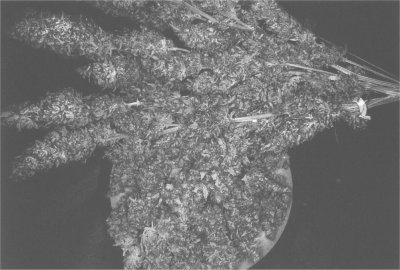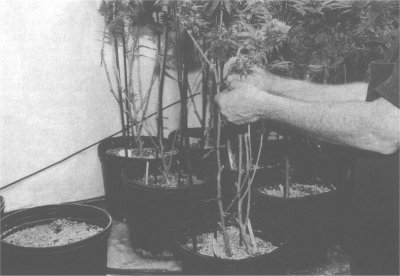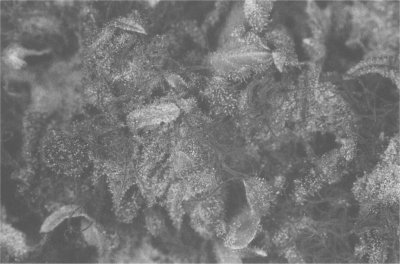The new garden was filled with 10 inch black containers in two trays. One tray held 44 containers in 11 rows lined 4 deep, side to side. It was lit by four 600 watt horizontal HPS lamps. The 4 x 10 foot area was lined with white polyethylene plastic on three sides and Styrofoam boards, which were easily moved around, on the fourth. The other tray held 52 containers in 13 rows four deep. It was lit by five 600 watt HPS lamps, and was also surrounded by polyethylene and Styrofoam reflectors.
The planting mix was completely organic, consisting of 10 percent each peat moss and worm castings and 40 percent each vermiculite and perlite. Rock phosphate was added at roughly 1/2 tablespoon per container.
The plants were placed in the containers as rooted clones about 6” high, with two or three sets of leaves. The original intent was to grow White Widow clones in their vegetative state under the four-light tray for about 10 days—until the Soma Jack clones were ready for the five-light system. That way, the Widows would be 18” to 24” tall when they were placed into flowering, approximately 10 days after the Jacks were planted.
That plan fell through for two reasons. First, the Jack clones were not ready on time. Secondly, there was a great demand for the clones and the gardeners decided to keep the plants in vegetative growth for an extra 20 days while taking cuttings from the undergrowth. By the time the plants were forced to flower, the Widows had been in vegetative growth for a total of 40 days and the Jacks for 20.
The plants were originally supported using bamboo stakes, but they grew too tall and heavy for them. The Widows were 3’ tall when they were finally placed in flowering. At ripening, they had grown 3 1/2 foot long stems that supported only the top canopy and were between 5’ and 6’ tall. The bamboo was eventually replaced by 6 foot wood strips and plastic-coated metal stakes, both of which worked well. The stakes were pushed to the bottoms of the containers to maximize support. Then the plants were tied to them using 8 inch paper-coated twist ties commonly used in nurseries.
The plants were pruned three times, at intervals of 10 to 15 days, before they were forced into flowering. Rather than cutting the tops and causing the plants to branch more, the lower growth Pruning For Giant Yields 87 was removed. Then, at forcing and again about two weeks after, all but six main branches were cut off. With the staking and removal of extraneous vegetation, each lead had direct access to light and adequate growing space.
The growers experimented with fertilizers to determine which one worked best during vegetative growth. The White Widows received Miracle Gro, (N-P-K ration 18-18-21) fish emulsion, (5-2-2) and Wonder Grow, a methanol-containing fertilizer which is unregistered but traded underground by orchid growers. During the flowering cycle the plants received Wonder Bloom, Miracle Gro (15-30-15) and Fish Emulsion Bone Meal (0-12-0). The fertilizers that performed best on this system were the fish emulsion and Fish Emulsion Bone Meal. The Wonder Grow produced the worst results and actually caused visible burning of the leaves. All of the fertilizers were measured to an electrical conductivity of 1000
1.
The Jacks received different fertilizers: Bill’s Perfect Fertilizer (65-11-5), General Hydro (5-5-6) and Max Sea (16-16-16 vegetative, 3-20-20 bloom). With these plants, the differences were visible but less striking. Bill’s Perfect Fertilizer produced the tightest buds and the highest yield.
The containers were fed by hand as needed, usually every three to five days. Need was determined by feeling the planting mix 2” below the surface in several containers. If it felt moist it was not watered, based on the assumption that there was more moisture in the bottom third of the container than in the top. Only when the top of the container was dry was it ready to be watered. Watering was accomplished using a two-quart water pitcher. It was filled from a five-gallon bucket of water-nutrient solution, then poured into the plant container.
In each garden the lights were evenly spaced, averaging 60 watts input per foot squared for the Widows and 57.7 for the Jacks. The horizontal HPS lamps were screwed into Hydrofarm reflectors, which are very efficient. The lamps were hooked to a 2 x 4 inch board that was bolted to the ceiling. The lamps had a V holder on either side, ending in an S hook. The S hooks on either side of the lamp were moved up or down the chain to raise or lower the light.
The reflectors were stationary, but with the close spacing of the lamps and the 2 foot distance between the top of the canopy and the bottom of the bulbs, light from the lamps crossed quite a bit. Also any light which hit the white Styrofoam or polyethylene plastic was reflected back to the garden. There was enough room between the evenly spaced leads for light to penetrate a foot or more down from the top of the canopy.
CO
2 was provided using a CO
2 generator. It was kept at 1,600 parts per million using an on-line meter connected directly to the generator. The generator created a lot of heat and some moisture in the room. A humidistat set at 60 percent humidity drew excess humidity from the room.
The nine lights and a CO
2 generator produced a lot of excess heat: 3,200 BTUs per 1,000 watts. About 17,300 BTUs were created by the lights and an average of 2,200 by the generator. The temperature would quickly rise to 90-100 degrees Fahrenheit on a 70 degree day. On a 90 degree day the room temperature would climb to 110 degrees.
To prevent an extreme heat scenario, the room was cooled using an external air-conditioner that pulled in cool air from a ceiling vent. This system was not completely effective. The gardeners complained that they were lured to purchase a ‘bargain,’ a used furnace/air-conditioner that proved to be unreliable. Internal air circulation was provided by an overhead fan, several window fans mounted from the ceiling and two turbo fans placed close to each other on the floor blowing air up to the ceiling. One improvement the gardeners suggested was to use enclosed, ventilated, reflectors with fans to prevent heat buildup in the room. This would reduce the need for air conditioning. The nine light ballasts were kept in a separate space, a closet with a small vent fan to move the heat from the ballasts to the attic.
Three weeks after forcing, new branch growth tapers off. The plant puts all of its energy into reproduction, producing clusters of flowers all along the branches. As long as they remain unpollinated, the clusters continue to grow. The clusters often link up, forming a solid bud consisting of the female flowers’ stigmas, to which any floating pollen will adhere. Since these plants were all female, there was no stray pollen, so all of the flowers remained unpollinated.
The Jacks in the larger tray had a different experience than their neighbors across the aisle. They were placed into the garden 20 days later and received only two ‘haircuts’, one at forcing and the other three weeks into flowering. They were only 15” to 18” tall at flowering and matured at under three feet. At the first trimming, all but three to five leads were removed. The plants were staked and tied to hold the leads in position. The second trim removed branches that had grown since forcing. These cuttings were also cloned, but took an extra three weeks to revert from flowering to vegetative growth. They were not ready to transplant until five weeks from cutting.



